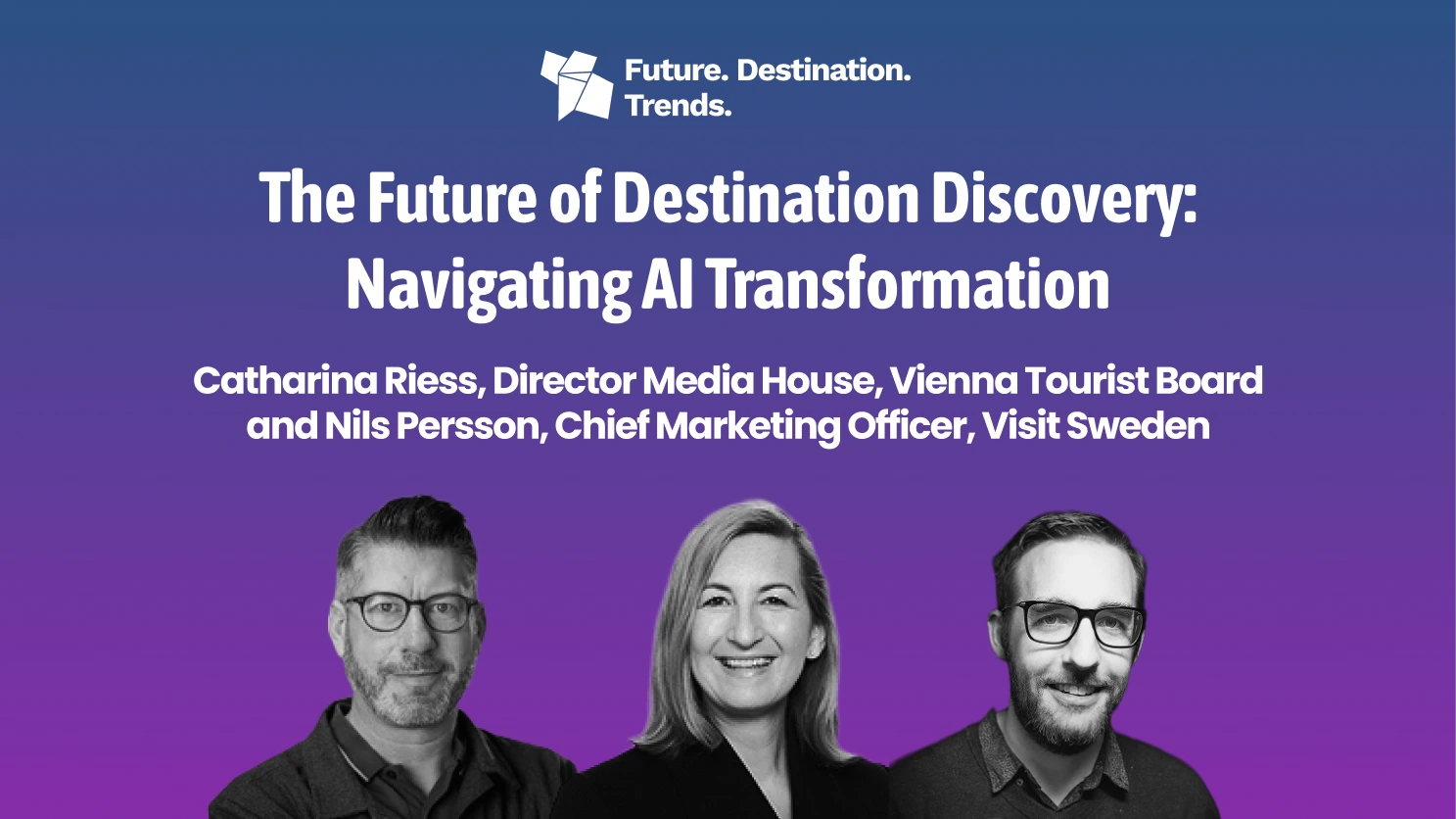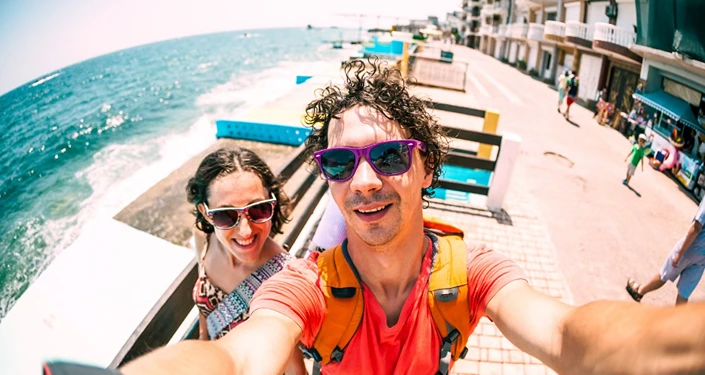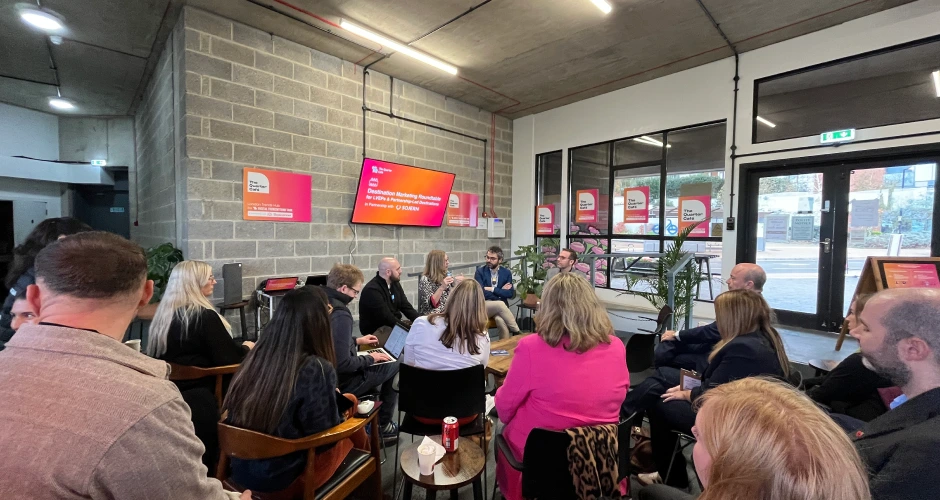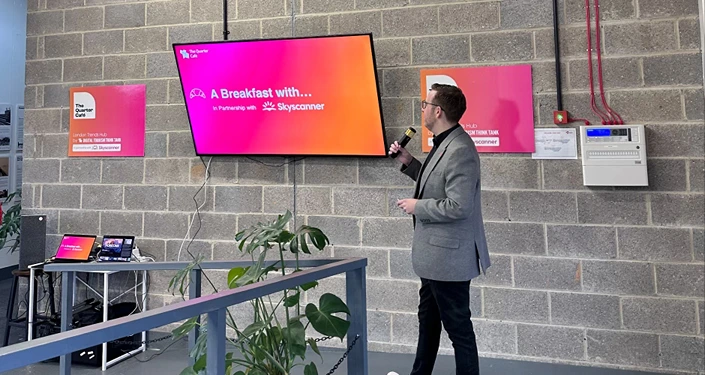LinkedIn Live | 2nd October 2025
Featuring Janette Roush, SVP of Innovation & Chief AI Officer, Brand USA
In conversation with Nick Hall, CEO & Founder, Digital Tourism Think Tank
The conversation around artificial intelligence in destination marketing has matured considerably since the initial wave of enthusiasm that accompanied ChatGPT's public release. What began as wide-eyed experimentation with prompt engineering and image generation has evolved into something far more consequential: a fundamental rethinking of how destination marketing organisations operate, create value and connect with travellers.
In a revealing LinkedIn Live session, Janette Roush, Brand USA's SVP of Innovation and Chief AI Officer, provided one of the most comprehensive accounts yet of what true AI integration looks like within a major destination marketing organisation. Speaking with the DTTT's Nick Hall, Janette outlined not just the tactical applications of AI tools, but the strategic framework and organisational philosophy required to move beyond superficial adoption towards genuine transformation.
What emerged from the 45-minute conversation was neither utopian enthusiasm nor cynical dismissal, but rather a pragmatic, detail-rich exploration of both AI's genuine capabilities and its current limitations. For DMOs navigating their own AI journeys, the insights offer a valuable roadmap through terrain that remains unfamiliar to many tourism organisations.
The Chief AI Officer Role: Defining the Mission
Janette Roush holds what may be a unique position in destination marketing: Chief AI Officer for a major national tourism organisation. The role itself speaks to Brand USA's commitment to treating AI not as an experimental side project but as a core strategic priority deserving dedicated leadership.
As Janette explained, her remit spans three distinct but interconnected domains. "The first one is internal looking at how we at Brand USA are using AI to make our jobs more affordable, to do things more efficiently, to make it more fun to do the work that we're doing." This internal transformation focuses on embedding AI into daily workflows across the organisation, from content creation to data analysis to communications.
The second domain extends this learning outward: "Taking everything that we're learning internally and extending that out into the US tourism industry. Making sure that destinations and tourism businesses understand the opportunity that's afforded to us by AI." This positioning of Brand USA as an industry educator and thought leader reflects a broader understanding of the organisation's role in strengthening the entire US tourism ecosystem.
The third focus addresses perhaps the most pressing strategic question facing DMOs today: "How can AI help to make the United States be more discoverable and more bookable as a destination for both our B2B partners as well as for consumers." This challenge cuts to the heart of changing consumer behaviour and the potential disintermediation of traditional destination marketing channels.
Internal Transformation: From Experimentation to Integration
The evolution of Brand USA's approach to AI mirrors what many organisations are experiencing, albeit perhaps on an accelerated timeline. Janette described moving beyond what she termed the "halo effect" where "it's just a thing that everybody has to do" towards strategic deployment focused on genuine productivity gains and creative enablement.
One of the most compelling examples Janette shared involved what she termed "vibe coding": using AI to rapidly develop single-use applications and websites that solve specific problems. She illustrated this with a hypothetical but highly relevant scenario based on Hurricane Sandy's impact on New York City tourism operations.
"In a post AI world, we could use AI to very quickly spin up an app or a website that could help them connect hotels that have guests that need to move to the hotels where there is availability," Janette explained. "The app itself doesn't need to be AI, it's AI that helps make code writing and website development accessible to anybody who has the curiosity to learn how to do it."
This represents a profound shift in organisational capability. Previously, such crisis response tools would have required either working with existing inflexible systems, negotiating emergency contracts with agencies or simply managing through manual processes. AI-assisted development compresses the timeline from concept to deployment from weeks to hours, fundamentally changing what organisations can accomplish in high-pressure situations.
Tool Selection and Strategic Deployment
When it comes to specific tools, Janette demonstrated the nuanced thinking that separates strategic AI adoption from unfocused experimentation. Rather than championing a single platform, she outlined how different AI models serve different purposes based on their training, capabilities and integration features.
"For ideation and writing, I really like Claude the most right now, as well as for anything technical, anything that requires coding," Janette explained. "ChatGPT - very general use for me. I also have many of the connectors enabled, so if I want to access, like all of our file storage is in Box, and I have the Box connector turned on for ChatGPT. So it makes it much more powerful for getting work done."
For image generation, she highlighted Google's recently released Imagen 3 model (referred to as "nano banana"): "It's very fast. So even if you don't love the first image that comes back, it's easy enough to spin up alternatives until you get what you need and it's only going to take 15 seconds or so per image. That has been a huge help when putting together presentations for me."
This multi-tool approach reflects a clear recognition that AI is "not a monolith" as Janette put it. Different models are "trained differently" and "fine tuned differently" and even behave inconsistently over time as server loads fluctuate. This reality demands that users develop fluency across multiple platforms rather than committing exclusively to a single vendor.
Deep Research Capabilities
One of the most practically valuable AI capabilities for destination marketers to turn to has been deep research functionality, now available across major AI platforms. Janette shared how Brand USA's communications team uses this feature extensively: "They're like, do you think you could run a deep research report on UK media? And over the last 12 months, how has their travel reporting changed? And in which publications in which newspapers still have dedicated travel and tourism desks?"
The resulting reports proved immediately actionable. "The report that came back, everybody was like, that is so great. Can we do it now for Singapore? Can we do it for Australia?" This research capability essentially provides organisations with on-demand market intelligence that would previously have required either substantial internal resources or expensive consultancy engagements.
However, Janette and Nick both noted that the quality of deep research outputs depends heavily on the specificity of prompts and source guidance. As Nick observed: "When you're really specific in asking or defining the sort of sources or even being really precise with the sources that it should look at, the results completely change." This requirement for skilled prompting represents an emerging competency that marketing teams must develop.
Creative Applications: Navigating the Authenticity Question
The discussion of AI's role in creative production revealed both genuine practical benefits and important philosophical boundaries. For presentation design, Janette described a personal challenge she set herself: "I said, I'm going to try something new at work using AI every single day, and I'm going to post about it on LinkedIn. And at the end of January, I had a good understanding of, okay, this is what it's great at and this is what it's terrible at."
This structured experimentation led her to Beautiful.ai for presentation development, which she described as "awesome" for creating visually stunning decks that "look like they are generated by somebody who works with artificial intelligence."
However, both Janette and Nick acknowledged significant limitations in AI's current creative capabilities. Nick shared his frustration attempting to use Gamma to design a comprehensive 60-page white paper: "I worked with Gamma for days. In the end, the verdict was no way, it is terrible and in the end, you know, I actually designed it myself and it took about a day, thinking, this is crazy. I've spent two days messing around with a very amateur looking AI tool."
This acknowledgement of AI fails underscores can be a reality check: AI creative tools work exceptionally well for certain formats and purposes whilst remaining inadequate for others. The key lies in understanding these boundaries rather than expecting AI to solve all creative challenges.
The Authenticity Imperative
Perhaps the most crucial insight for destination marketers concerned the use of AI-generated imagery and video. Janette was clear: "We don't want to trick consumers, right? We don't want to make fake destination images, but there's all kinds of images that we can do, or avatars we can create that are very obviously fake."
She shared a clever tactical approach: creating an avatar of herself "that looked like I was created out of yarn" rather than attempting photorealistic human avatars. "Real Janette avatar, look, it's choppy, it looks fake. It hits that uncanny valley where it's uncomfortable to watch. The yarn version of me delivering the same information you lean in because it's really cute and it's obviously it's not real, obviously it's AI."
This approach resolves a fundamental conflict in destination marketing: how to leverage AI's creative capabilities without undermining the authenticity that underpins destination brand credibility. By making AI usage deliberately visible and even playful, organisations can avoid the reputational risk of appearing to deceive whilst still benefiting from AI's efficiencies.
For consumer-facing destination content, this boundary becomes even more critical. DMOs build trust by providing accurate representations of experienceable realities. Deploying AI-generated images of destinations, attractions or experiences risks fundamentally undermining that trust, even if such imagery could be produced more cheaply than traditional photography.
Consumer Behaviour: The Discoverability Challenge
The conversation turned to perhaps the most strategically significant question facing DMOs: how changing consumer behaviour threatens traditional models of destination marketing. Nick shared recent research from GSIQ revealing that 26% of 25-34 year-old travellers now use "AI-based travel planning tools and apps" as a primary source of inspiration, placing such tools nearly on-par with destination websites themselves.
"That raises the same sort of questions that we've been asking about the relevance of our brands online and how we engage and which tools we engage through," Nick noted. "How do we ensure we're more visible and we have more attribution for our visibility in LLMs like ChatGPT?"
Janette's response cut to the strategic heart of the matter. She argued that DMOs must fundamentally rethink their value proposition: "We're not going to solve the problems by having websites that just repeat the same information that is already been commoditised. So if the information you have on your website is just a regurgitation of anything that you can find in the Google Point of Interest API, then you are not providing unique value."
This represents a sobering assessment for DMOs whose websites function primarily as directories of businesses, attractions and practical information. As Janette explained: "Addresses and opening hours of businesses in your destination, that's commoditised, that is already in Google's system. They are going to deliver that as part of an AI overview. You are not going to get traffic for having that kind of information on your website."
The Path Forward: Stories and Context
If basic information is commoditised, what unique value can DMOs provide? Janette outlined two critical differentiators: "The information that's not been commoditised is going to be more stories about our destination and things that are backed up by expert opinions or the point of view of real people."
This shifts the DMO role from information repository to storyteller and curator, providing the narrative context and local expertise that generic AI models cannot replicate. It positions destinations as interpretive layers that add meaning and perspective beyond mere facts.
The second element of Janette's strategic response addresses where rather than what: "I think the step after that is thinking about how we reach people when they are inside the tools that they're increasingly going to use for travel planning? So how do you reach people inside of ChatGPT and these other tools?"
Model Context Protocol: The Future of Discoverability
It was at this point in the conversation that Janette introduced what may be the most important technical concept for DMOs to understand: Model Context Protocol (MCP). For an audience of marketing leaders rather than developers, Janette provided an accessible explanation of why this matters.
"APIs have historically been the pipes of the internet," she began. "That is how bookings happen. That is how we connect to websites in order to understand, okay, great, these are the dates that tickets are available for this attraction. Here's the pipe where I put in my credit card information and I book that trip."
The limitation of traditional APIs is that "you need programmers in order to write code that connects endpoints." Every integration requires bespoke development work to specify how different systems communicate with each other.
Model Context Protocol changes this dynamic fundamentally. "MCP is self-describing," Janette explained. "It will just tell the language model, this is what I do, this is where the credit card information goes, this is where the dates go, this is what kind of information I can provide you back."
The implication of this requires us to completely rethink how we look at both traditional development and AI integration: rather than requiring custom development for each potential integration, an MCP server can be discovered and utilised by any compatible AI system without human intermediation. "Language models don't need programmers and developers writing code," as Janette put it.
Strategic Implications for DMOs
Janette positioned MCP as potentially representing the future of how destinations remain relevant in an AI dominated visitor funnel. "I think the way that is going to happen in the future is through Model Context Protocol. If destinations don't create MCP servers for our information, then commercial organisations will do it and then charge us for visibility in it."
This framing should alarm any DMO comfortable with their current digital strategy. Just as Google's dominance created dependency and extraction dynamics that disadvantage destinations, a similar pattern could emerge in the AI era if DMOs fail to establish direct connections between their content and the AI models travellers increasingly use for planning.
"As nonprofits and as owners of the brands of our destinations, that's where our opportunity sits, to create this neutral source of information," Janette argued. This positions DMOs not as passive content producers hoping to be discovered, but as active architects of the infrastructure through which AI systems access destination information.
Looking forward, Janette envisioned how this might manifest: "If you think about ChatGPT today, it's all text-based. But it's not going to always be text-based. In one or five years when you are in your account, if you want to start dreaming about a trip, perhaps it will spin up something that looks like what we would call a website today, like some kind of visual interactive interface."
For such interfaces to accurately represent destinations, "the visuals need to be fed in from somewhere. I think that is something that destinations can provide and then the stories behind why would you want to come to this destination? That's something that we can provide that's unique to where we sit in the ecosystem."
Practical Guidance: From Early Stage to Advanced
Towards the conclusion of the conversation, Janette provided specific guidance for destinations at different points in their AI maturity journey. For organisations still at early stages, she emphasised the importance of formal AI policies and secure infrastructure.
"Please put an AI policy in place," Janette urged. "Our policy, the Brand USA policy, is available on our website and I will share it with anybody who shoots me an email." She emphasised that policies need not be complex: "I think that is really important to set the table stakes for how your organisation is addressing AI and doing it in a secure and safe way."
This includes providing paid AI tools rather than allowing staff to use free consumer accounts. "If you are in that space where you are letting everybody use their free ChatGPT account at work, you are not alone, that is still very common. But we have to move past that point now. We are several years into this, so it's time to take AI seriously."
The security concerns are real and consequential. Paid enterprise accounts provide SOC 2 compliance, training can be turned off so that proprietary data doesn't become part of future model training and perhaps most importantly, access can be revoked when employees leave. As Janette pointedly asked: "If somebody leaves your organisation, they don't get to keep their email account, they don't get to keep access to your shared files. So why would you let them keep access to everything they've put in ChatGPT?"
Advanced Implementation
For more mature organisations, Janette described a shift towards systematic integration across departments: "How are we making sure that we're bringing everybody in the company on board? For me, that means meeting department by department and looking at what workflows can be augmented with AI, what are the custom GPTs, which are just reusable prompts?"
This departmental approach recognises that AI applications vary significantly based on function. What works for the communications team differs from what benefits operations or data analytics teams. By tailoring implementation to specific workflows, organisations can maximise adoption and value derived from it.
She also noted the importance of identifying and empowering those ready to push boundaries: "Identify the people who are ready to move to that next step, who wants to have a conversation about building these MCP servers, because I think this is the perfect time to lean into those opportunities."
This points to a tiered approach where organisations provide baseline tools and training for all staff whilst supporting more advanced exploration for those with particular interest or aptitude. Not everyone needs to understand the technical details of an MCP, but organisations benefit from having some team members who can engage with emerging capabilities.
Organisational Philosophy: Wonder and Experimentation
Beyond specific tools and tactics, the conversation revealed an organisational philosophy that may be part of Brand USA's most important gift to the broader industry partners. Janette described her initial approach to AI learning: "When generative AI first came out, I said, I'm going to try something new at work using AI every single day, and I'm going to post about it on LinkedIn."
This public commitment created accountability and forced systematic exploration rather than passive observation. By the end of January 2023, she had developed a good understanding of what it's great at and this is what it's terrible at. This experiential learning proved far more valuable than theoretical knowledge or vendor presentations.
The philosophy extends to how Brand USA positions itself within the broader industry. Rather than guarding competitive advantage, the organisation actively shares learnings, policies and insights. This approach recognises that the challenges facing DMOs are largely common rather than competitive and that collective progress and sharing benefits the entire sector.
Janette even referenced an upcoming keynote she's preparing on "the role of wonder in AI adoption at organisations," exploring how cultivating a sense of awe and curiosity about AI capabilities creates organisational conditions for successful implementation. This psychological dimension of technology adoption receives little attention in typical implementation approaches, where the focus is often purely on technical and process considerations.
Strategic Implications: Redefining the DMO Role
Looking back at this highly insightful conversation, several strategic imperatives emerge for destination marketing organisations navigating the AI era:
- Authenticity remains paramount. Whilst AI offers remarkable creative capabilities, DMOs must resist the temptation to generate synthetic representations of their destinations. The core value proposition of destination marketing lies in truthful representation of experienceable realities. AI should enhance workflows and extend capabilities whilst keeping authentic human-created content at the consumer interface.
- Commoditised information provides no competitive advantage. If the same information exists in multiple places accessible to AI models, maintaining it on a destination website creates no strategic value. DMOs must differentiate through stories, local expertise, curated perspectives and narrative set in context so that it adds meaning beyond basic facts.
- Discoverability requires active infrastructure investment. Waiting passively to be discovered by AI systems puts DMOs at the mercy of intermediaries who may extract value or distort representation. Creating MCP servers and other direct connections between destination content and AI models represents the modern day equivalent of SEO investment.
- Internal transformation enables external innovation. Before destinations can leverage AI for consumer-facing applications, they must transform internal workflows and build organisational fluency with AI tools. This internal foundation proves a prerequisite to strategic external deployment.
- Multi-platform fluency trumps single-vendor commitment. Given the rapid evolution of AI capabilities and the varying strengths of different models, organisations benefit from maintaining access to multiple platforms rather than committing exclusively to any single vendor. This requires budget allocation and user training across multiple tools.
- Formal governance enables rapid innovation. Rather than stifling progress, clear AI policies and security frameworks provide the foundation for confident experimentation. They transform data protection officers from barriers into partners and create shared understanding of acceptable boundaries.
- Industry collaboration accelerates collective progress. The challenges facing DMOs are largely sector-wide rather than organisation-specific. Sharing learnings, policies and frameworks strengthens the entire industry's capacity to navigate disruption successfully.
Conclusion: Moving Beyond Halo Effects
The conversation between Janette Roush and Nick Hall provided something increasingly rare in discussions around AI in tourism: depth over hype, specificity over generality and honest acknowledgement of both capabilities and limitations. For DMOs at various points in their AI journey, this offers important guidance grounded in actual implementation experience rather than speculative possibility.
What emerges most clearly is that successful AI adoption requires not just technical capabilities but organisational transformation, strategic clarity and philosophical grounding. It demands moving beyond the "halo effect" where AI is implemented simply because it's trending towards purposeful deployment aligned with specific organisational objectives.
Brand USA's approach demonstrates that becoming an AI-first organisation is neither simple nor quick, but it is achievable with committed leadership, systematic exploration and willingness to share learnings openly. For the destination marketing sector facing genuine disruption in how travellers discover and plan trips, such leadership provides both inspiration and practical roadmap.
The next chapter of this story will reveal which DMOs successfully navigate this transformation and which DMOs find themselves disadvantaged by commercial platforms that fill the vacuum destinations leave unfilled. The opportunity exists for DMOs to establish themselves as authoritative sources that AI systems reliably surface when travellers seek inspiration and information. Seizing that opportunity requires action rather than observation, investment rather than hesitation and strategic conviction about the enduring value destinations provide in the age of AI.






.svg)














.webp)
